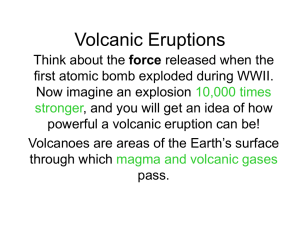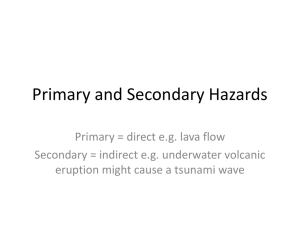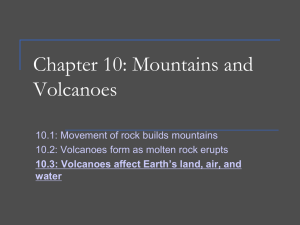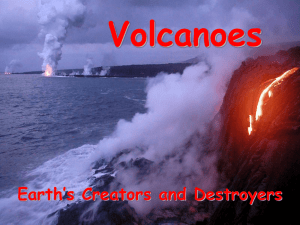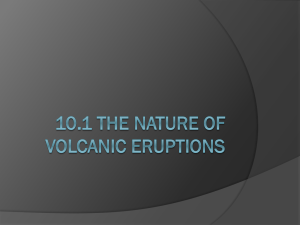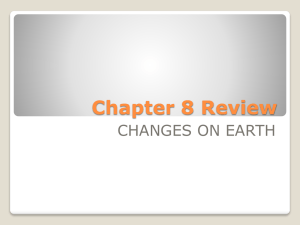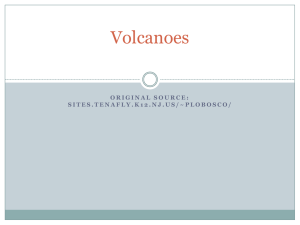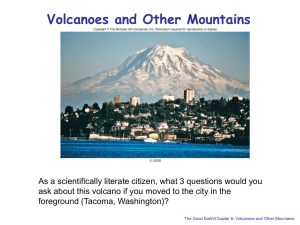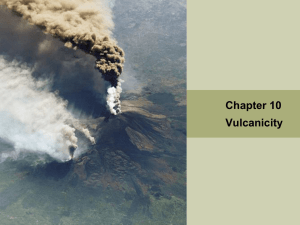File
advertisement
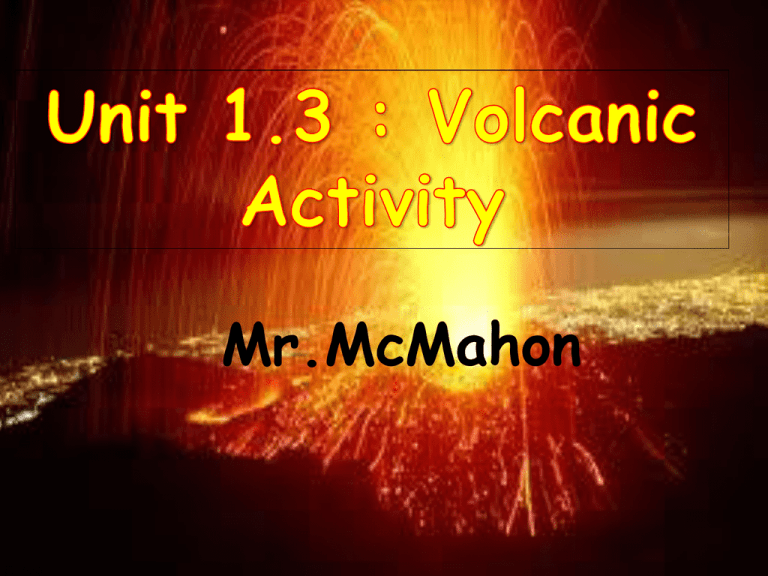
Mr.McMahon Learning Objectives 1. To understand WHY volcanic activity occurs. 2. To understand HOW the distribution of Volcanic activity relates to plate boundaries. 3. To EXPLAIN how Volcanic activity can be predicted. 4. To be able to identify different types of volcano and name its parts 5. To understand the impact that volcanic activity has had on the Irish landscape 6. To study how geothermal energy can be harnessed. 7. To understand the effects that Volcanoes have on people. Why do Volcanoes Erupt ? • Ans – Pressure • Molten Magma is less dense than hard rock. • It is capable of flow. • Gasses held under high pressure in a magma chamber force the magma to the surface through vents. • Vents develop along fault lines, hotspots, ridges and trenches. Mount Pinatubo eruption as seen from space http://www.youtube.com/watch?v=jRfEGvp6wDU What is a Volcano ? • A volcano is a opening in the earths crust through which molten material from the interior can make its way to the surface. • Volcanoes form along plate boundaries where rock is recycled. • The distribution of the worlds volcanoes can be explained by studying the worlds plate boundaries. Global distribution of Volcanoes http://www.youtube.com/watch?v=JfHBCYTzuck Global Distribution • The global distribution of volcanoes can be explained by their location in relation to fault lines. • Volcanoes are found on convergent, divergent and transform boundaries. Destructive Boundaries A • When subduction occurs as plates collide the descending old crust is melted in the asthenosphere. The melted rock rises through the crust through a vent. • This creates central vent eruptions along chains of fold mountain's. • E.g. The Andes, South America Divergent Boundaries • At Divergent Boundaries new crust is created. • As the plates pull apart the sea floor spreads and magma rises to fill the void. • This results in the creation of new crust and ocean ridges which rise to form islands. • Iceland and the Mid-Atlantic Ridge Cycle of Volcanic Activity • Active (Live): Erupts on a Regular basis. • Dormant (live): Volcanoes that have not erupted in recent recorded history. Can be asleep from 100-600 years. • Extinct (dead) Has not erupted since historical times. There is no lava supply. Volcanoes In Europe Eurasian Plate African Plate Volcanic Material • Magma – Molten material inside the earth. • Lava – over 1000 C. Low in silica so it is less viscous and runny. • Acidic Lava : Contains gas bubbles that cannot escape easily and so explodes with force. http://www.youtube.com/watch?v=ePr a9ycif7M Pyroclastic Material • This is the material ejected by a volcano. It includes ash, cinders, Pebbles and rock –Volcanic bombs and pumice. • Lahars : Devastating mudflows that result when volcanic material mixes with snow melt water or heavy rainfall http://www.youtube.com/watch?v=yvG_N7eqMWk&feature=related Volcanic Gasses Steam Carbon Monoxide Chlorine Hydrogen Sulphurous Oxides. Depending on the type of lava explosions can be devastating. • Acid Rain can result when the gasses react with moisture in the atmosphere. • • • • • • Volcanic Landforms • Volcanic landforms fall into two main categories. Intrusive : Formed inside the earth. Extrusive formed on the surface. Extrusive : Central Vent Eruption • Form at destructive boundaries. • As lava and other material builds up on the surface it creates a volcanic cone. Anatomy of a Central Vent Eruption Cloud of Pyroclastic Material Crater Lava Flow Secondary Flow Alternate Layers Of Ash and Lava Pipe Vent Magma Chamber Types of Central Vent Eruptions 1. Composite Volcano : Layers of alternate ash and lava. 1 2. Lava Dome: Thick viscous lava that solidifies to form a dome over a vent. 3. Caldera. A large surface crater where a cone collapses in as it was consumed by the Magma chamber below it. 3 2 Fissure Eruptions • Fissures are cracks caused by plate movement . • Krafla : This is a 20KM long fissure in Iceland that has been erupting for over 30 years spewing lava. • The Derry Antrim Plateau formed from fissure eruptions 65 million years ago. Hot Spots • Hot Spots are places where volcanic activity takes place far in from plate margins. • They from where there is often a thin crust overlying a hot mantle. • A plume of magma rises from the mantle and melts a spot in the crust through which lava escapes. • E.g. The Hawaiian Islands. Intrusive Landforms • Landforms of volcanic activity that are created beneath the surface. • Magma cools slowly inside the crust to create intrusive igneous rock e.g. Granite. • Plutons is the collective name for intrusive landforms. http://www.youtube.com/watch?v=A5LdZJiKsVk Intrusive Landform's … cont’d • Batholiths: The Largest of the Plutons. Coarse with large crystals. They are exposed after denudation wears away the crust above them. • E.g. Leinster Batholith Dublin, Wicklow Mountains. Laccoliths • Dome like structures of hard intrusive igneous rock that bulged upwards against the overlying rock strata. Sills • Horizontal sheets of igneous rock that run parallel to the under and overlying rock strata. • They formed when magma forced its way into the bedding planes of sedimentary rock where it cooled and solidified. Dykes. • Vertical sheets of volcanic rock that cooled and solidified in vertical cracks in the crust. Plutonic Landforms Predicting Volcanic Activity Measuring Gas samples • Increase in sulphur and carbon levels in soils on or close to volcanic slopes. • Increase in the temperatures of groundwater. • Changes in the shape of the volcano as magma upwells within. • Some volcanic activity may be preceded by plumes of smoke, ash and steam. • Magma heating rock in the upper mantle may cause small tremors. Beneficial effects of Volcanoes • The creation of fertile soils. Ash and cinders are natural fertilisers. Cash crops such as tea, coffee, cotton and coco are grown in volcanic soils. • Tourist Attractions: Yellowstone National Park, USA and Mt. Etna , Sicily. • http://www.youtube.com/wat ch?v=bVYD2gtq4IA • Geothermal Activity: A renewable source of energy whereby the heat of volcanically heated springs are harnessed to provided clean green energy. E.g. Iceland. Before and after http://www.youtube.com/watch?v=UK--hvgP2uY Mount St Helen’s Fallout. Volcanic Activity In Ireland • As we have studied Ireland moved from 60 south of the equator to its present position • The Derry – Antrim Plateau • The Leinster Batholith Slemish Mountain The Derry-Antrim Plateau • Formed by basaltan extrusive igneous rock that cooled slowly on the surface. • Covers 4,000km2 rising to 350m in height. • When the lava cooled 60 million years ago it covered over the original chalk seafloor. • The Giants Causeway on the Antrim coast is but a part of the Derry-Antrim Plateau. • To understand how the structure was formed we can look at Iceland today. • When the Eurasian –American plates pulled apart 60 million MYA the crust thinned and magma cooled slowly The Leinster Batholith • A batholith is a Pluton- an intrusive igneous formation that formed slowly inside the crust. • Large crystals had time then to form in granite. • The Leinster batholith stretches south west over a distance of 120 km. C D A B Geothermal Energy in Iceland • Geothermal energy is a form of renewable energy derived from heat deep in the earth's crust. • Geothermal Energy has been around for as long as the Earth has existed. "Geo" means earth, and "thermal" means heat. So, geothermal means earth-heat. • Geothermal power is generated in over 20 countries around the world including Iceland, the United States, Italy, France, Lithuania, New Zealand, Mexico, Nicaragua, Costa Rica, Russia, the Philippines, Indonesia, the People's Republic of China and Japan. Iceland • Iceland –The land of Ice and Fire. • 307,000 Population. • Lowest Population Density in Europe. • 85 % of all houses and 30% of electricity in Iceland is produced by geothermal energy. http://www.geoberg.de/en/2010/06/12/geothermal-energy-in-iceland/ How is Geothermal Energy used • Domestic : Homes, swimming pools, public baths • Industrial: Fishfarming-de icing holding pools, Kiln drying timber in saw mills, electricity production. http://www.youtube.com/watch?v=kWN 5yXCYeXc ? How Geothermal Energy Works http://www.youtube.com/watch?v=rfUQy86ZMpQ Key Concepts 1. Volcano 2. Pyroclastic Material 3. Lava (Basis and Acidic) 4. Magma 5. Active Live 6. Dormant Live 7. Extinct 8. Intrusive 9. Extrusive 10.Central Vent 11.Caldera 12.Fissure 13.Hotspot 14.Lahar 15.Geyser 16.Cascadia 17.Pacific Ring of Fire 18.Plutons 19.Laccoliths 20.Batholiths 21.Sills 22.Dikes 23.Plateau 24.Geothermal Energy
